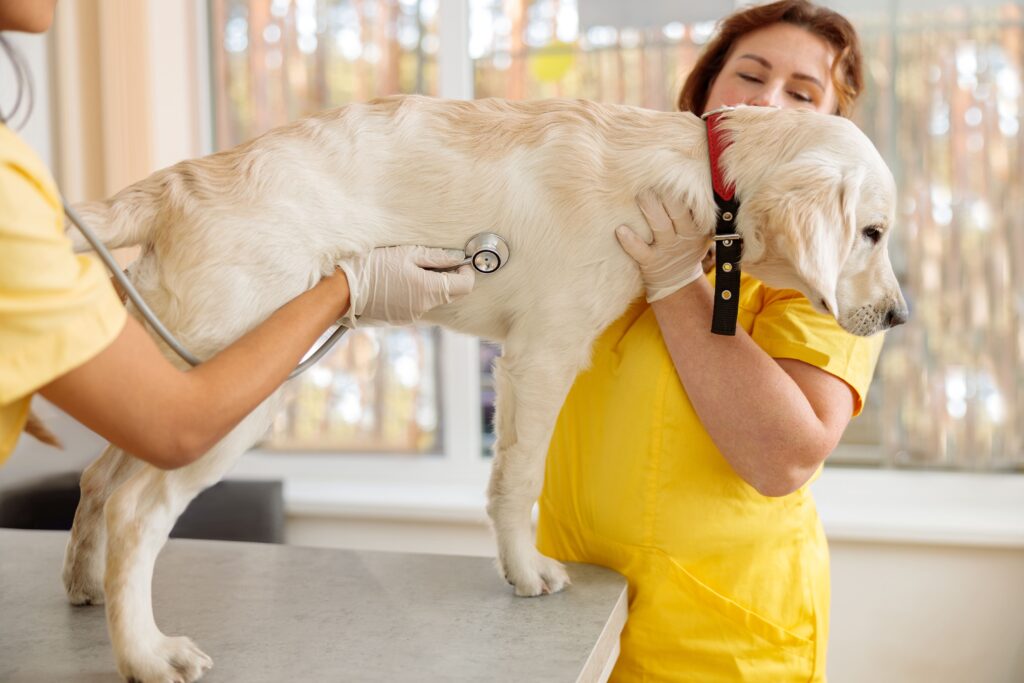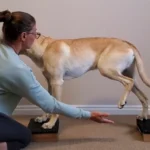
Contents
When your dog starts slowing down, struggles to climb stairs, or shows weakness in the back legs, it may not just be old age. It could be arthritis. This common condition affects many dogs as they get older, especially in their hind legs, and can make simple movements painful. The good news is that with the right care and treatment, dogs with arthritis in back legs can still enjoy comfort, mobility, and a better quality of life.
In this guide, we’ll explain the early signs of arthritis, treatment options that really help, and simple lifestyle changes you can make to support your dog every day.
Understanding Arthritis in Dogs
What is Arthritis?
Arthritis is an inflammatory condition affecting the joints, leading to pain, stiffness, and reduced mobility. The most common form in dogs is osteoarthritis, especially in older dogs and large breeds. It typically impacts the hind legs, making it difficult for dogs to walk, jump, or climb stairs.
How Arthritis Affects Your Dog’s Hind Legs
Arthritis in your dog’s hind legs causes joint deterioration, leading to weakness, swelling, and muscle mass loss. As the condition progresses, the inflammation and pain in the hips, knees, and other hind limbs make movement increasingly difficult. The discomfort from the arthritis leads to muscle atrophy, further weakening the affected legs and limiting mobility. Over time, the swollen joints and stiffness cause more severe limitations, making tasks like walking, stair climbing, or even getting up from rest uncomfortable or even impossible. If left untreated, this painful inflammation can severely impact your dog’s quality of life, making it crucial to manage the condition early with pain relief, exercise, and veterinary care.
How to Spot Arthritis in Your Dog’s Back Legs
Symptoms of Arthritis in the Hind Legs
Dogs with arthritis often exhibit the following signs in their hind legs:
- Limping or Difficulty Walking
One of the most noticeable signs of arthritis in your dog’s hind legs is limping, particularly after rest or a period of inactivity. This happens because joint stiffness builds up during rest, making it painful for your dog to get moving again. Dogs might have a slight limp in one leg or drag their back legs when walking, especially after exercise or during long periods of rest. - Pain Relief Needs
If your dog starts to show signs of swaying hind end, tremors, or stumbling, it may indicate that the pain from arthritis is affecting their balance and coordination. This can be a result of inflammation and joint discomfort in the hind legs. Offering pain relief options or consulting a veterinarian is essential to help alleviate this discomfort and prevent further mobility issues. - Reluctance to Exercise
Dogs suffering from arthritis in their hind legs often show reluctance to exercise or play. They may avoid activities they once enjoyed, such as walking, running, or climbing stairs. The pain caused by joint inflammation makes movement uncomfortable, leading to a decrease in their activity levels. If your dog avoids stair climbing or has trouble getting up after lying down, it’s a clear sign that their hind legs are affected. - Collapsing or Coordination Loss
In more advanced cases, arthritis can lead to collapsing or coordination loss. After walking, playing, or exerting themselves, your dog may have difficulty maintaining balance. This happens because the arthritis has worsened, affecting their ability to properly control their hind legs. If your dog collapses or stumbles frequently, it’s a sign that their hind leg joints need attention and care.
When to See a Veterinarian
If you notice any of these symptoms, it’s crucial to consult a veterinarian for a proper diagnosis and treatment plan. Early intervention plays a key role in managing arthritis and preventing further complications. A veterinarian can help determine the severity of the condition, assess the amount of muscle mass loss in the affected hind leg, and rule out other potential causes such as hip dysplasia or degenerative myelopathy.
A veterinarian will likely recommend diagnostic tests like X-rays or blood tests to assess the extent of the damage in the hind legs. These tests help identify if there are other underlying issues affecting your dog’s hind leg health, allowing your vet to provide a targeted treatment plan that will alleviate pain, improve mobility, and increase your dog’s quality of life.
Diagnosis and Treatment Options
Diagnosis of Arthritis in Dogs
To determine if your dog has arthritis, your veterinarian will first perform a thorough physical examination. This includes assessing how your dog moves, focusing on the hind legs for signs of weakness or limping. The vet may also recommend X-rays or blood tests to evaluate joint health and detect any swelling or joint degeneration. These diagnostic tools help gauge the extent of joint damage and identify underlying causes of hind leg weakness, such as hip dysplasia or degenerative myelopathy.
Treatment Options for Dogs with Arthritis
Depending on the severity of arthritis, your veterinarian may recommend the following treatments:
- Pain Management
The primary goal in treating arthritis is pain relief. Your vet may recommend medications to reduce swelling and alleviate pain in the affected joints. These medications help manage discomfort and improve your dog’s mobility. - Joint Protection & Mobility Aids
In addition to that, using joint protection methods can help your dog move more easily and comfortably. This includes providing an orthopedic bed for better support, using ramps instead of stairs to avoid unnecessary strain on the hind legs, and offering non-slip mats around the house. These aids can reduce joint stress and enhance your dog’s mobility, making everyday activities like walking or climbing less painful. - Physical Therapy
Non-invasive treatments can help improve mobility and reduce pain in dogs with arthritis. These therapies stimulate the body’s natural healing processes, promote tissue regeneration, and reduce inflammation in the hind legs. Physical therapy is often used in combination with other treatments to maximize results and improve joint function.
Tips for Living with a Dog with Arthritis
Environmental Modifications
Making your home comfortable for a dog with arthritis in the hind legs is key. Provide orthopedic bedding, use ramps for easier access to furniture, and ensure non-slip surfaces to prevent slipping.
Pain Management Strategies
Pain management plays a significant role in your dog’s quality of life. In addition, try physical activity like swimming for low-impact exercise that supports joint health and reduces strain.
Monitoring Your Dog’s Condition
Regular vet visits are essential to monitor the progression of arthritis. Keep an eye on symptoms like decreased walking speed, muscle mass loss, and stumbling. If these worsen, consult your veterinarian to reassess the treatment plan.
Emotional Support
Dogs with arthritis may feel frustrated or stressed due to their limitations. Providing emotional support, maintaining a calm environment, and engaging in activities that stimulate their mind can help keep them comfortable and reduce stress.
FAQs: Dogs with Arthritis in Back Legs
Q1: How do you treat dogs with arthritis in back legs?
Treatment for arthritis in dogs typically involves pain relief, anti-inflammatory medications, and joint supplements. Regular exercise, physical therapy, and environmental modifications can also help improve mobility and manage symptoms effectively.
Q2: What are the symptoms of dogs with arthritis in back legs?
Common symptoms of arthritis in dogs include limping, stiffness, reluctance to move, and difficulty with stair climbing. You might also notice muscle mass loss, swaying hind end, or tremors in the hind legs, particularly after physical activity.
Q3: How can I help my dog with arthritis at home?
To help your dog with arthritis, provide orthopedic bedding, ensure they have a healthy diet, and encourage gentle exercise like swimming. Supplements like Omega-3 fatty acids and regular visits to the veterinarian for check-ups are also helpful.
Q4: When should I consider euthanizing a dog with arthritis?
Euthanasia should be considered if arthritis causes severe pain, loss of quality of life, and an inability to move comfortably. If your dog is in constant pain despite treatment and can no longer enjoy daily activities, consult your vet for guidance.
Q5: How to help a dog with arthritis naturally?
Natural treatments for arthritis in dogs include Omega-3 fatty acids for joint support, acupuncture for pain relief, and regenerative therapy to promote healing. Additionally, provide a healthy diet, and ensure regular low-impact exercise like swimming or walking.
Conclusion
Managing arthritis in dogs, especially in the hind legs, requires a comprehensive approach that includes diagnosis, treatment, and prevention. Early identification of symptoms like weakness, limping, and pain is crucial for effective intervention. By working closely with your veterinarian, you can ensure your dog receives the best possible care to manage their arthritis and maintain their quality of life.
At North MS Pet Emergency, we specialize in providing expert care for dogs with arthritis and other mobility issues. If your dog is showing signs of arthritis or experiencing difficulty walking, contact us today for professional care and guidance.Contact us now for immediate care or visit us for after-hours emergency care for pets.




